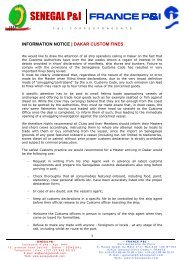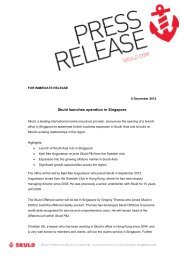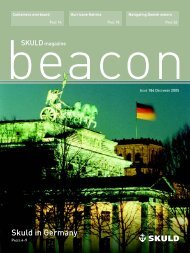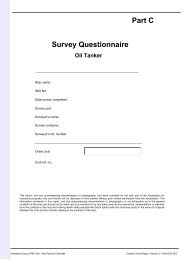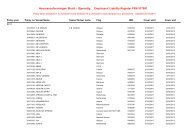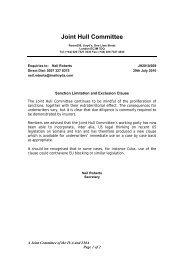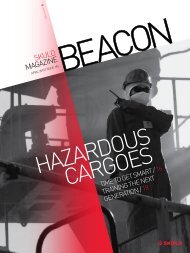Create successful ePaper yourself
Turn your PDF publications into a flip-book with our unique Google optimized e-Paper software.
Photo: Scanpix<br />
A stowaway from the Dominican Republic, injured in a<br />
scuffle with crew members on the Cypriot-flagged cargo<br />
ship Columbia One, is lowered off the ship in Miami<br />
Potential for terrorism<br />
A headline in the Boston Globe on 26<br />
March <strong>2004</strong> read, "FBI denies link<br />
between terrorist, LNG tankers". The<br />
article referred to an accusation that<br />
terrorists had entered Boston as<br />
stowaways on LNG tankers from Algeria.<br />
Although the FBI concluded that the<br />
stowaways had no terrorist links, this<br />
does highlight the danger from<br />
stowaways if their motive is terrorism.<br />
Even where the stowaways are not found<br />
to have any terrorist motives, they can<br />
still present difficulties to members if<br />
they come from designated high-risk<br />
areas. In early 2001, well before the 9.11<br />
terrorist attacks in the USA, two Iraqi<br />
stowaways were disembarked at a port in<br />
Photo: Courtesy of the U.S.Coast Guard<br />
the USA. The US Immigration Authorities<br />
detained them in a federal prison. A<br />
charge of USD 100 per day was levied<br />
against owners for the stowaways. The<br />
stowaways are still in detention and,<br />
given the present political climate, are<br />
not expected to be released in the near<br />
future.<br />
Costs involved<br />
The stowaway represents a financial<br />
burden to both owner and charterer. In<br />
the present market, where owners have<br />
a better bargaining position, they may<br />
negotiate clauses into their charterparties<br />
that place liability for the cost of<br />
stowaways on charterers, or share the<br />
cost burden depending on how the<br />
stowaway got on board.<br />
If a stowaway cannot be discharged at<br />
the next convenient port, he will have to<br />
be maintained on board the vessel with<br />
food, clothing and water. This results in<br />
extra overtime for the crew if they have to<br />
act as guards. Most ports require the<br />
Master to declare that a stowaway is on<br />
board the vessel. Some ports may<br />
require that guards be employed on the<br />
vessel to ensure that the stowaway does<br />
not escape.<br />
Fines may be levied against both the<br />
Master and the owners. Depending on<br />
the location, the fines could be<br />
substantial.<br />
The South African Immigration Authority<br />
has a pure fine (non-refundable) of<br />
around Rand 2,500 (about USD 300) per<br />
stowaway. Should the Master of the<br />
vessel fail to declare the presence of a<br />
stowaway, a further non-refundable fine<br />
of Rand 10,000 (about USD 1,200) will be<br />
imposed. In Australia, under section 229<br />
of the Migration Act, a maximum penalty<br />
of AUD 10,000 (about USD 6,700) can be<br />
levied regardless of whether the<br />
stowaway escapes or remains on the<br />
vessel. It is an offence to bring a noncitizen<br />
that does not hold a visa into the<br />
country.<br />
How to stop stowaways getting on board<br />
High risk areas<br />
South Africa, Morocco, Tanzania, Algeria,<br />
West Africa, Eastern Europe, Colombia<br />
and China are high-risk areas where<br />
total vigilance is required.<br />
Container ships<br />
There is an organised criminal industry<br />
dedicated to the trafficking of humans.<br />
Container vessels are vulnerable to<br />
stowaways and extra care must be taken.<br />
• Examine empty containers and softtop<br />
containers. If the container has<br />
holes on the top or sides, this may be<br />
an indication that the cargo is human<br />
• Where the vessel is required to remain<br />
at port longer than usual and receives<br />
cargo during that period, enquiries<br />
should be made and a detailed inspection<br />
carried out of the containers received<br />
• The crew should focus attention on the<br />
seals to ascertain whether they have<br />
been tampered with, look unusual or<br />
are missing<br />
BEACON 17


